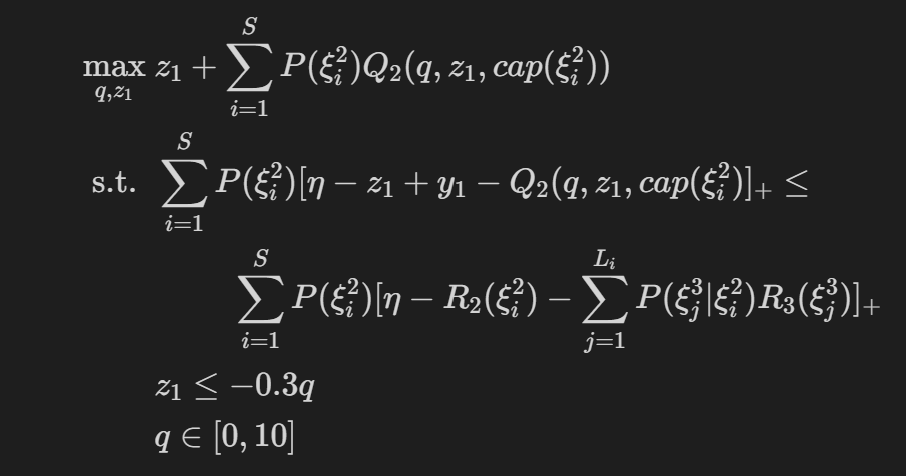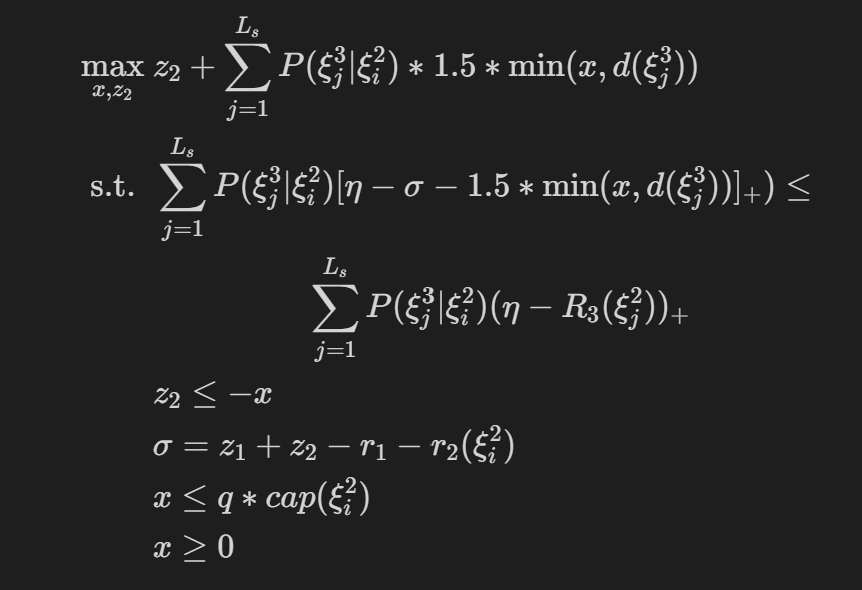Our eventual goal is to
(1) establish a solver package implementing the multicut algorithm we proposed to generic multi-stage problem with SSD concerned [1].
(2) standardize a data format/structure to store the multi-stage problem setting as well as the benchmark information for our SSD method.
Currently, we have realized our algorithm on a toy problem ---- three-stage news-vendor problem:
-
First stage: agents require certain units of premium from vendors
variable:
$ q\in (0,10)$ - units of premium
coeffients:
-0.3 - cost per unit of premium -
Second stage: vendor buys news paper from agent, the available quantity range depends on the invesment
variable:
$x \in (0,+\infty)$ - units of news paper
coeffients:
-1 - cost per unit of news paper
random variable:
$\mathrm{cap}$ - the availble buying quantity is upper bounded by$\mathrm{cap}*q$ -
Third stage: vendor sells news paper to individuals
variables:
$z \in (0,x)$ , sold quantity of news paper
coeffients:
1.5 - retail price of news paper
random variables:
$d \in (0,+\infty)$ , quantity of demands
We write the SSD constrainted problem in the formulation form of (10)-(15) in [1] , given random reward sequence as
then
The above news-vendor is a one-dimensional problem and we will extend this into a multi-dimension by considering multi-items to sell and the vendor can rebalance the stocks after the inital stocking.
We use the following notation to formulate the problem:
Assuming vendors have
-
First stage: a vendors stocks different items
variable:
$ x_1= (x_{1,1}, x_{1,2},..., x_{1,n})$ - quantity vector of item
coeffients:
$c_1\in R_+^{n}$ - cost vector of items -
Second stage: the vendor sells the items regarding the inventory and demand, use the revenue and additional budget to restock items
variable:
$x_2$ - quantity vector of items to restock
$s_2$ - quantity vector of items to sell
coeffients:
$p_2$ - price vector
$c_2$ - cost vector
$b_2 \in R $ - additional budget
random variable:
$d_2$ - demand vector of items -
Third stage: vendor sells stocks regarding demands
variable:
$s_3$ - quantity vector of items to sell
coeffients:
$p_3$ - price vector
random variable:
$d_3$ - demand vector of items
Then the problem can be written as $$ \begin{align*} \max_{x_1,z_1} &~ z_1 + \sum^S_{i=1} P(\xi^2_i) Q_2(x_1,z_1,\xi^2_i)\ \mathrm{s.t.}&\sum^S_{i=1} P(\xi^2_i) [\eta-z_1 +y_1- Q_2(x_1,z_1,\xi^2_i)]+\leq \ &~~~~~~~~~~\sum^S{i=1} P(\xi^2_i)[\eta-R_2(\xi^2_i)-\sum^{L_i}{j=1} P(\xi^3_j|\xi^2_i)R_3(\xi^3_j)]+\ &~ z_1\leq -c_1 x_1\ &~ c_1 x_1\leq b_1 \ &~ x_1\in R^n_+ \end{align*} $$ The$Q_2(x_1,z_1,\cdot)$ respoding to
$$ \begin{align*} \max_{x_2,z_2,s_2} &~ z_2 + \sum^{L_s}{j=1} P(\xi^3_j|\xi^2_i) Q_3(s_2,x_2,\xi^3_j)\ \mathrm{s.t.}&\sum^{L_s}{j=1}P(\xi^3_j|\xi^2_i) [\eta-\sigma - p_2(\xi^2_i) (x_1-r_2)]+)\leq \ & ~~~~~~~~~~~~~~~~~~~ \sum^{L_s}{j=1} P(\xi^3_j|\xi^2_i) (\eta - R_3(\xi^2_j))+ , \ &~ z_2\leq -c_2(\xi^2_i) x_2 + p_2(\xi^2_i)s_2,\ &~ s_2 \leq x_1 ,\ &~ s_2 \leq d_2 ,\ &\sigma = z_1+z_2-y_1-y_2(\xi^2_i) ,\ &c_2(\xi^2_i) x_2\leq p_2 (\xi^2_i) s_2+ b_2,\ &~ x_2,s_2\in R^n+,\ &~ z_2 \in R \end{align*} $$$Q_3(s_2,x_2,\xi^3_j)$ is simply evaluated as $$ \begin{align*} p_3(\xi^3_j)\min(x_1+x_2-s_2,d_3(\xi^3_j)) \end{align*} $$
toy_two_stage_newsvendor_SSD showcased how SSD constrainted solution is different from the non-SSD constrainted solution
three_stage_single_item is the toy we showcase our multi-cut algorithm
three_stage_multi_item_newsvendor is the toy we showcase our multi-cut algorithm
[1] Darinka Dentcheva, Mingsong Ye, Yunxuan Yi (2022). Risk-averse sequential decision problems with time-consistent stochastic dominance constraints

